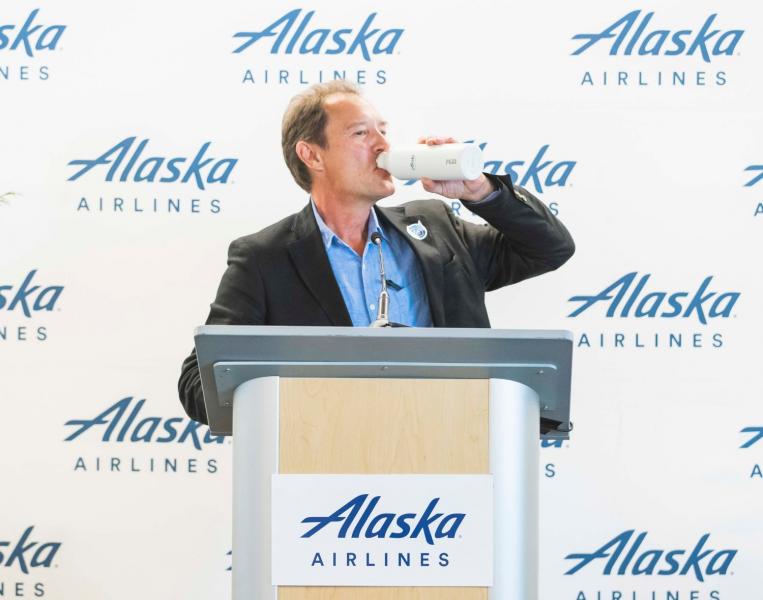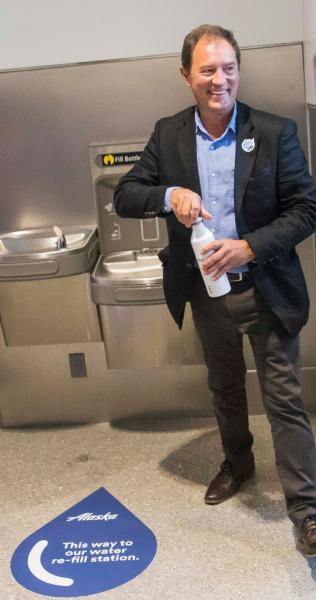
At Seattle-Tacoma International Airport, we embrace the spirit of doing more every day to reduce our environmental impact and help passengers mitigate the impacts of their travel. That’s why we’re working hard to reduce single-use plastic, increase recycling, and improve water quality.
Whether bringing a reusable water bottle, buying carbon offsets for flights, or taking higher-occupancy modes of travel to and from the airport, passengers play an important role in helping the Port achieve our goal to be the greenest and most energy-efficient port in North America.
We cannot do it alone, so we are making it easier for passengers to reduce reliance on single use plastic water bottles by providing conveniently located liquid drains and recycle bins at TSA security checkpoints and hydration stations in the concourses, and we applaud Alaska Airlines’ recent #FillBeforeYouFly campaign to reduce single-use plastic bottles by passengers. With 10 more stations on the way and an interactive map in the free Sea-Tac App showing hydration stations nearest you, passengers can bring reusable bottles knowing they can quickly refill with fresh clean water before their flight.
Single-use plastics can take over a thousand years to decompose and contain toxic chemicals harmful to the environment. Americans purchase about 50 billion water bottles per year, averaging about 13 bottles per month for every person in the U.S. That means by using a reusable water bottle, you could save an average of 156 plastic bottles annually. And at Sea-Tac Airport, with over 50 million passengers every year, making reusable water bottles your choice for travel is an easy way to make a big difference!

Besides single-use plastics, our waste reduction and recycling programs prevent, recycle, and compost waste from all aspects of airport operations. For example, we require airport restaurants and lounges to sort their waste, label containers, and use only approved and environmentally preferable food serviceware. We partner with our local food bank to donate 600 meals per week of unsold food to local communities, helping food-insecure neighbors, and keeping food from landfills while reducing costs. We support airline recycling efforts through incentivized recycling and efficient airfield waste management systems, education and outreach, and technical assistance. We also require contractors to recycle construction waste from capital projects.
While passengers will appreciate our hydration stations, local fish and wildlife also benefit from our Salmon-Safe Certification. As the first U.S. airport to achieve this certification, we’re serious about our commitment. We build, operate, and manage the airport with a focus on preventing toxins, conserving water, and protecting valuable habitat to preserve the health of local streams and its inhabitants.

More to do
These efforts are paying off by eliminating the use of 1.3 million plastic water bottles each year through our hydration stations and 41 percent diversion (3,500 tons) of airport terminal waste from landfill each year (our goal is 60 percent by 2020). But there’s still more we can do. Plastic packaging, containers, and food waste removed from planes accounts for nearly a third of airport waste but still only 10 percent in our airfield system gets recycled. Airlines could further prevent, recycle, or compost over 60 percent or 1,600 tons of this waste each year. We welcome partnerships from all our carriers in the spirit of — and shared commitment to — sustainability.
The planet will not wait for us. Let’s work together to end single-use plastics in the waste stream at our airport, protect the environment, and fly more sustainably!
Commissioner Steinbrueck spoke at an event with Alaska Airlines on September 12, 2019 for its #FillBeforeYouFly initiative to plant trees when passengers bring their own reusable water containers.


